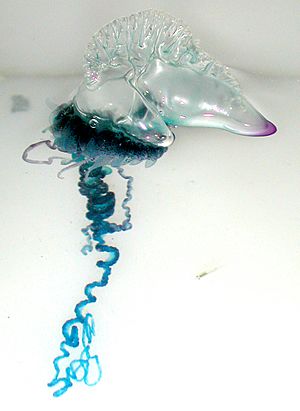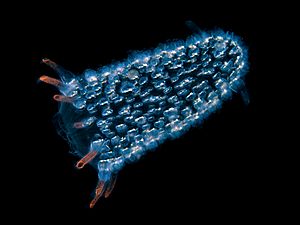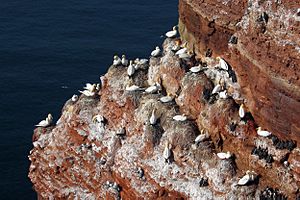Colony (biology) facts for kids
In biology, a colony means a group of living things from the same species that live together. They often share a common space or work together.
Usually, the members of a colony are related to each other. Sometimes, like with tiny animals called bryozoa, they are exact copies (called clones). Other times, like in ant or bee colonies, they are part of a big family.
Some colonies are even more connected. For example, the Portuguese man o' war looks like one animal. But it's actually a group of four different, simpler animals (called zooids) that are joined together. They work as a single unit.
Many colonies build a shared home, like a nest. Sometimes, they are linked just by how they act. The very close teamwork seen in termites, ants, bees, and wasps is called eusociality. This means they have a complex social structure with different jobs for different members.
The idea of a colony mostly applies to animals. However, some tiny living things, like protists and prokaryotes (which are very simple organisms), can also live in colonies.
Animals That Live in Colonies
Many different types of animals form colonies. Here are some examples:
- Bryozoa: These are tiny water animals that often live in large groups. They create hard structures.
- Choanoflagellata: These are very small, single-celled organisms. They can sometimes form simple colonies.
- Cnidaria: This group includes jellyfish and corals.
- Coral: Many corals are made of tiny animals called polyps. These polyps live together in huge colonies. They build the large coral reefs we see.
- Portuguese Man o' War: As mentioned, this is a floating colony of different specialized parts.
- Entoprocta: These are small, stalked animals that live attached to surfaces. They often form colonies.
- Graptolites: These are extinct animals that lived in colonies. They looked a bit like small branches.
- Insects: Many insects are famous for living in highly organized colonies.
- Termites: These insects build complex nests and have a queen, workers, and soldiers.
- Hymenoptera: This group includes ants, bees, and wasps.
- Ants: Ant colonies can have thousands of members, all working together.
- Bees: Honey bees live in hives, with a queen, drones, and worker bees.
- Wasps: Some wasps, like yellow jackets, also form social colonies.
- Phoronida: These are small, worm-like animals that live in tubes. They often live in groups.
- Sponges: Sponges are simple animals that can grow in large, connected groups.
- Tunicates: Some tunicates, like sea squirts, live in colonies. They can be attached to rocks or float in the ocean.
Images for kids
-
A colony of Brandt's cormorants in Point Lobos, California
-
The pelagic Marrus orthocanna is a colonial siphonophore made of two types of zooids
See also
 In Spanish: Colonia (biología) para niños
In Spanish: Colonia (biología) para niños






